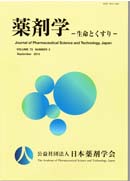Volume 78, Issue 2
Displaying 1-15 of 15 articles from this issue
- |<
- <
- 1
- >
- >|
Foreword
-
2018 Volume 78 Issue 2 Pages 55
Published: 2018
Released on J-STAGE: March 01, 2018
Download PDF (1008K)
R&D
-
2018 Volume 78 Issue 2 Pages 56-61
Published: 2018
Released on J-STAGE: March 01, 2018
Download PDF (11339K)
Research Laboratory
-
2018 Volume 78 Issue 2 Pages 62-66
Published: 2018
Released on J-STAGE: March 01, 2018
Download PDF (4792K)
Young Researcher
-
2018 Volume 78 Issue 2 Pages 67-71
Published: 2018
Released on J-STAGE: March 01, 2018
Download PDF (1317K) -
2018 Volume 78 Issue 2 Pages 72-76
Published: 2018
Released on J-STAGE: March 01, 2018
Download PDF (1312K)
Current Topic
-
2018 Volume 78 Issue 2 Pages 77-81
Published: 2018
Released on J-STAGE: March 01, 2018
Download PDF (1360K) -
2018 Volume 78 Issue 2 Pages 82-85
Published: 2018
Released on J-STAGE: March 01, 2018
Download PDF (2433K)
Introduction
-
2018 Volume 78 Issue 2 Pages 86-90
Published: 2018
Released on J-STAGE: March 01, 2018
Download PDF (5585K)
Report
-
2018 Volume 78 Issue 2 Pages 91-92
Published: 2018
Released on J-STAGE: March 01, 2018
Download PDF (163K) -
2018 Volume 78 Issue 2 Pages 93
Published: 2018
Released on J-STAGE: March 01, 2018
Download PDF (145K) -
2018 Volume 78 Issue 2 Pages 94-96
Published: 2018
Released on J-STAGE: March 01, 2018
Download PDF (241K)
News
-
2018 Volume 78 Issue 2 Pages 97-99
Published: 2018
Released on J-STAGE: March 01, 2018
Download PDF (265K)
-
2018 Volume 78 Issue 2 Pages 100
Published: 2018
Released on J-STAGE: March 01, 2018
Download PDF (166K)
Regular Article
-
2018 Volume 78 Issue 2 Pages 101-108
Published: 2018
Released on J-STAGE: March 01, 2018
Download PDF (8100K)
-
2018 Volume 78 Issue 2 Pages e2
Published: 2018
Released on J-STAGE: March 01, 2018
Download PDF (122K)
- |<
- <
- 1
- >
- >|
